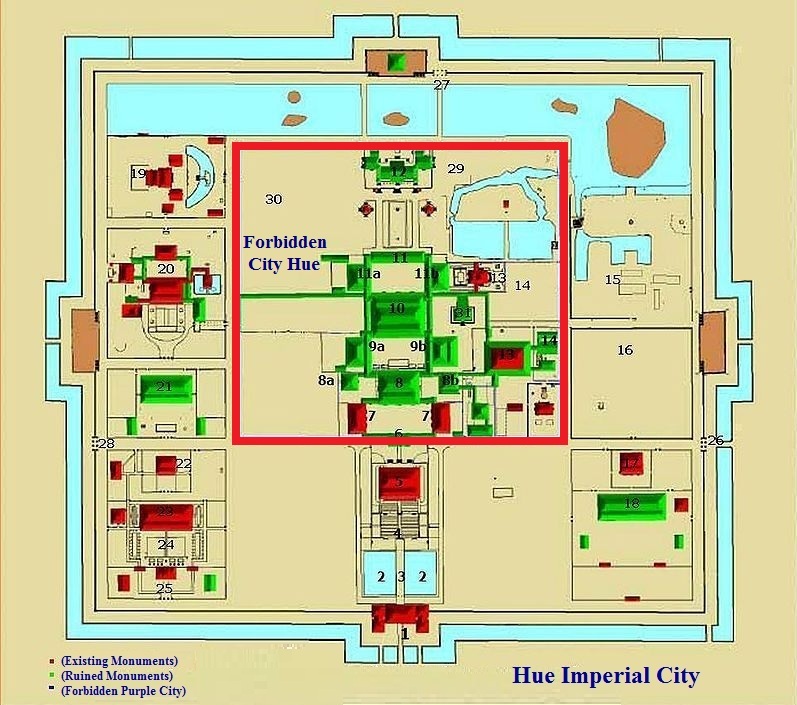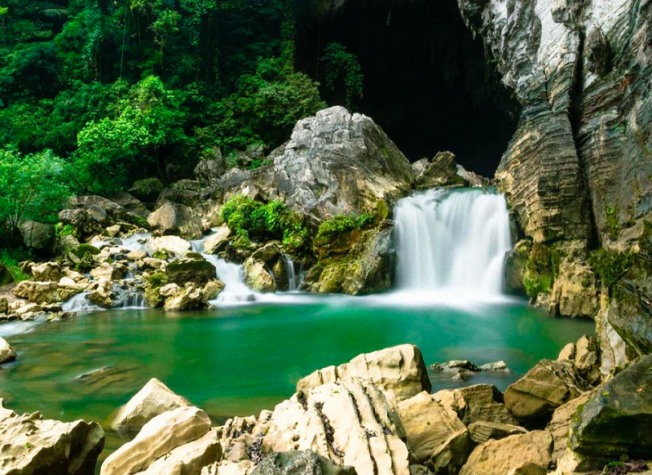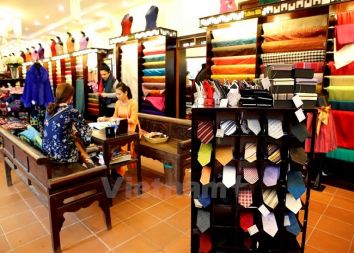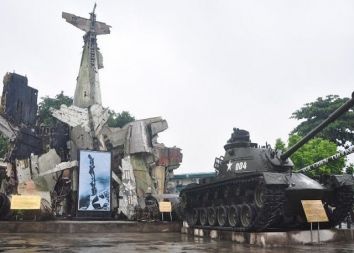Hue Forbidden City: Living Area for the Nguyen Emperors
Hue Forbidden City (also known as Forbidden Purple City in Hue): This was square ground 320m X 320m, and surrounded by the brick wall. It served as living and working areas for Kings, Queens, Minor Wives/ Concubines/ Eunuchs of the 13 Kings of the Nguyen Dynasty from 1804 to 1945.
- Location: Hue City, Thua Thien Hue Province, Vietnam
- Opening Hours: Daily from 7.30AM - 5.30PM; Mon - Sun
- Entrance Fee: 200k/Adult (Combo Ticket Recommended)
- Dress Code: Required (you can borrow scarfs at temple's entrances)

Map of Hue Forbidden City: 6. Dai Cung Mon (Entrance of Fornidden City) - 7. Ta vu & Huu vu - 8. Dien Can Chanh (Can Chanh Palace) - 8a. Võ Hiển Palace - 8b. Văn Minh Palace - 9a. Trinh Minh Palace - 9b. Quang Minh Palace - 10. Can Thanh Palace - 11. Khon Thai Palace - 11a. Thuan Huy Institute 11b. Duong Tam Institute - 12. Kien Trung Palace - 13. Thai Binh Pavillion - 14. Vu Uyen Garden - 18. Thai Mieu - 29. Ngu Tien Office - 30. Luc Vien - 31. Dien Minh Than.
Forbidden Purple City located on the same north-south axis, in the middle of the Hue Imperial City More) and the Hue Citadel. There were many buildings in this area used for different funtions, but all of these comstractions were destroyed in the wars, especially in 1947 (French War) and in 1968 (the Tet Offensive of the Vietnam War):
- Can Chanh Palace (where the Emperors worked daily) - 8. Dien Can Chanh:
Can Chanh Palace was built in 1804, after which it was repaired many times. The Can Chanh Palace was for the king to set up the court, often received foreign ambassadors, held royal banquets and the Nguyen court, now has become ruins due to being destroyed from in 1947. Infront, on two sides were 2 houses named Ta Vu and Huu Vu used by Gorvernment Officers as the Waiting Rooms before they could go inside the Can Chanh Palace to meet the Kings.
- Can Thanh Palace (the residence of the Emperors) - 10. Can Thanh Palace:
The Can Thanh Palace before 1811 named Trung Hoa Palace, burned in February 1947. Can Thanh Palace was living area of the Kings, and was the center of the Forbidden City. This was located behind Can Chanh Palace - where the king set up the court, in front of the Khone Thai Palace - the former palace of Thua Thien Cao Queen.
- Khon Thai Palace (the residence of Hoang Quy Phi) - 11. Khon Thai Palace:
Khôn Thai Palace is located right behind Can Thanh palace. This palace was the residence for the Queen, Hoang Quy Phi. The palace has a main hall, Cao Minh Trung Chinh, established in the third Gia Long year (1804). The president of 7 compartments, pre-president and post president were 9 compartments, covered with yin and yang tile.
- Kien Trung Palace (used to be the residence of King Bao Dai and Queen Nam Phuong) - 12. Kien Trung Palace.
Dien Kien Trung is located at the northernmost point of the Shinto axis through the center of the Forbidden City. The electric mode is a European-style combination of French architecture, Italian Renaissance architecture and Vietnamese traditional architecture. The electric facade is decorated with colorful pieces of ceramic.
In front of the garden is a landscape garden, with three dragon staircase leading up to the electric platform. The main floor has 13 porch doors: the space between 5 doors, two spaces on each side of the 3 doors, the two electric corners on each side of the two doors further jut out. Upstairs is the attic, doing the same procedure as the main floor. At the top is a tile roof with rows of decorative balustrades in Vietnamese style. Kien Trung Palace was later destroyed in December 1946 by the Viet Minh in a strategy of scorched earth resistance.
- There were some more constructions in the Forbidden City:
Many other sonstructions in Forbidden City used for different functions: Reading houses (Royal Library built in 1821 by King Minh Mang), Residence for minor wives and concubines of the Kings to live, and other works to serve the daily needs of the king and his family members such as Thuong Thien Duong (where serving food), Duyet Thi Duong (royal theatre) ... All of them does not exist any more except 2 buildings already restored: Duyet Thi Duong Royal Theatre and Thai Binh Lau (Royal Library).
Recommended Tours to visit Hue Forbidden City: Hue City Tour 1 Day or Half Day, Hue City Small Group Tour, Hue Walking Tour, Hue Sightseeing Price Car.
See Also:

![]()
![]()
![]()
![]()
![]()
Best of Vietnam

Best Vietnamese Food You Have to Try in Vietnam
Best Food in Vietnam: Vietnamese Traditional Food is top World well known to be both healthy and...

10 Best National Parks in Vietnam
Vietnam Travel Guide: If you look for the Best Wildlife Discovery Experience in Vietnam, here are...
Read More
Best Souvenir to Buy in Vietnam
If you look for Best Things to Buy when traveling to Vietnam to bring home for your family & friends...
Read More
The 10 Best Places to Visit in Vietnam
Vietnam Travel Guide: Home to an extensive collection of historical and cultural attractions,...
Read More
Top 10 Museums You Should Not Miss in Vietnam
Vietnam, 4.000 years old country has a unique and lengthy history, culture with 54 ethnic groups. It...
Read MoreFind your trip
Vietnam Best Tours
Vietnam Car Rental
Vietnam Travel Blog
- Vietnamese People: Origin, History, Culture and Traditions
- Vietnam Currency: Best ATM and Places to Exchange Money
- Vietnam Map: Regions, Cities & Provinces Map of Vietnam
- What is illegal Things in Vietnam: Rules & Laws for Tourists
- Best Time to Travel to Vietnam to Avoid the Bad Weather
- Vietnam News: Population & Religions of 54 Ethnic Groups









